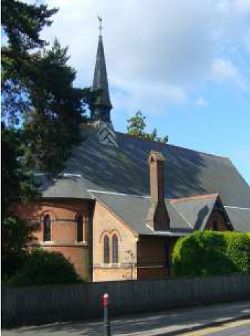History: St Saviour
The building of the Church
 St Saviour's church in Dry Hill Park Road, Tonbridge was built in 1875 mainly in response to those who wanted a more Anglo-Catholic style of worship. In 1873 a committee of local residents planned to form a separate parish in the area with new church dedicated to St Augustine.
St Saviour's church in Dry Hill Park Road, Tonbridge was built in 1875 mainly in response to those who wanted a more Anglo-Catholic style of worship. In 1873 a committee of local residents planned to form a separate parish in the area with new church dedicated to St Augustine.
The Archbishop of Canterbury (Tonbridge was then in the Diocese of Canterbury) decided that “any further accommodation which may be needed in the Parish would be more conveniently met by a Chapel of Ease to the Mother Church than by a separate Church and District.” Mr John Deacon, a patron of the Vicar of Tonbridge (Rev John T Manley), gave the land in Dry Hill Park and the foundation stone was laid on 31 July 1875. The architect was Ewan Christian and local builders, G Punnett & Sons, carried out the work at an estimated cost of £3,000.The seating capacity was 252, some 200 fewer than planned originally. 11 were for the minister and his household and the remaining 241 were to produce a sum of £144.4s per annum to be assigned to the spiritual person serving the church. The church was consecrated by the Archbishop of Canterbury, Archibald Tate, on 15 July 1876.
Its historical development
In 1882 the St Saviour’s congregation sought funds for a Mission Hall to serve the needs of local people and to house a Sunday School. The necessary £600 was raised and on 2 May 1883 the Mission Room was opened on the far side of Shipbourne Road. A coffee room and classrooms were added in 1887. The building was bought by the British Red Cross Society in 1960 and used for some years as their hall.
In April and May 1914 the east end of the church was carpeted, the Communion rail cushion and hassocks were replaced and a carpet presented for the chancel, together with the necessary brass rods. In 1919 the Reverend John and Mrs LeFleming gave a sanctuary prayer desk in memory of their son Lawrence who had been baptised in the church and was killed in action in 1918.
New heating was installed in 1919, costing £160. Throughout the church’s history generous gifts have been made to enhance the beauty of the church and its equipment. These have included memorial windows in the chancel, an oak table, a psalm board and portable lecterns. The windows at the east end contain high quality Victorian glass.
There are very few memorials within the church. The Ten Commandments are on two brass plaques at the east end and, in the nave, the other significant memorial is to Cecil Golding and was erected in 1928.
The organ was completely rebuilt and renovated in 1925 at a cost of £352 and dedicated on 7 June that year. The renovation of the organ took precedence over a proposed new vestry at the west end of the church. However, the organ was brought forward so that the pipes were inside the chancel and the existing vestry increased in size as a result. In 1934 the organ was equipped with an electric blower so a boy no longer had to operate the blowers. It was dismantled and cleaned in 1953. It was again cleaned and overhauled in 1969 for £385.
Alterations at the west end of the church to provide a small kitchen, toilet facilities and develop the downstairs area were made in 1993. The Jubilee celebrations at St Saviour’s took place on 18 July 1926.
The centenary of the church was celebrated in July 1976 with worship, music, drama, a flower festival and thanksgiving. St Saviour’s celebrated its 125th anniversary on 15 July 2001 with a commemorative service at which the preacher was Bishop Graham Dow, formerly a curate in the Parish, and a flower festival.
The present
There have been various aspirations to extend the church over the past decade and there was an increasingly urgent need to improve the lighting and heating and to provide easier disabled access.
Dorothy Stonely was born and lived within a few minutes walk of St Saviour’s church and worshipped here all her life. In 2002 she left a legacy to be used “for the benefit of St Saviour’s church in the repair, maintenance and improvement of their place of worship”. With her gift it has been possible to renew the flooring, heating and lighting, replace the pews with chairs, improve the disabled access and redecorate the church.
The work was undertaken in the summer of 2010 and completed by November that year. The main contractor was Civils of East Peckham and the re-ordering of the church received a commendation from the Tonbridge Civic Society. The church now provides a flexible space which can be used for concerts and other suitable events.
A service of thanksgiving for the re-ordering of the church was held on 6 March 2011.
September 2011